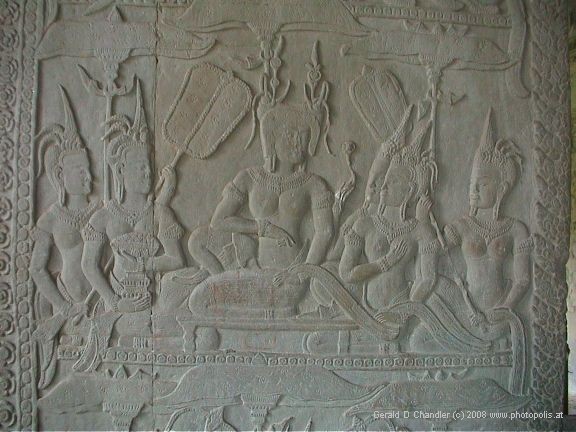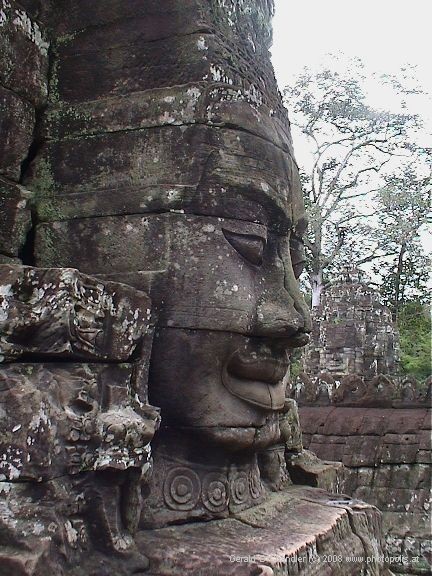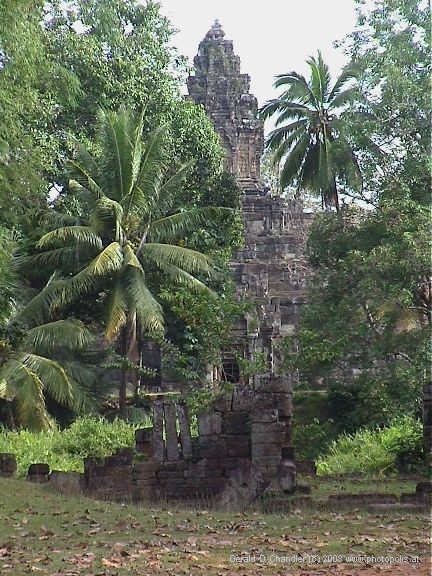Home | Front Page | Blog | Index | New | Contact | Site Map
Siam Reap
Angkor Temples
Hill of the Gods
Phnom Penh
School of Death
Sihanoukville
Torpedo Boat
Kaoh Kong Casino
Foto Show

China 2001
Vietnam 2001
Laos 2001
Thailand 2001

|
Stone Magic
Angkor, the very name evokes jungle mystery, an ancient civilization long forgotten, dilapidated stone remnants overgrown with vines and moss. It speaks of stone mountains, giant faces, delicate dancing maidens and bearded holy men, five-headed serpents with cobra-like hoods, elephants and rhinos, gods and demons, Siva and Vishnu and Buddha. Angkor is all this and more. Not just a temple, it is a city of temples built by not one king but by a dynasty of kings, ancient Khmer kings who worshipped Indian gods.
And the crown jewel of this ancient empire is without doubt Angkor Wat, the temple city, which as its name implies housed a city within its walls. On our first visit, the biggest surprise was the moat that encircles the outer wall of the temple. The heavy rains of the current rainy season had filled it to capacity and it looked more like a river than a mere moat. The second surprise was the extent of the place, which is more than a kilometer on a side. First comes the long causeway across the moat to the west gate or gopura. Then another long causeway from the west gopura to the inner enclosure and its west gate. The second causeway crosses no water, although there are a couple of ponds either side of it, but still it is set higher than the surrounding grassy fields and decorated with the inevitable naga serpents to indicate that it is in effect a naga bridge. In Khmer religious belief, the bridge allows the visitor to cross from this world to the world of the gods as exemplified by the temple.The temple itself is not a place of worship but a place of residence. It is intended as the home of the god for whom it is built. In the case of Angkor Wat that god is most probably Vishnu.

An Angkor Aspara |
Once through the inner enclosure, the complexity of the main temple takes over. One is drawn up, and up, and up towards the central sanctuary. As you cross through the gate of the inner enclosure, you are confronted with a staircase that carries you up to the first level. There you walk past four courtyards that would once have been filled with water to another staircase that brings you to the second level where you are finally confronted with the central platform with its five towers. Here also you are confronted with the staircase to the third level. It seems unassailable, sheer, impassable. The steps are not only steep but shallow and so require not only strength but agility and a head for heights. But when you finally get to that last platform, your reward beyond self-satisfaction is the cool airiness that surrounds you. It is as if you have ascended from a hot, humid, tropical plain to a cool, airy, mountain resort.
This, the highest of the three platforms, is surrounded by a gallery that is open to both sides, hence the delightful breeze that permeates it even in the hottest part of the day. From this gallery you have a wonderful view of the temple and the countryside beyond. Each corner of this platform is anchored by a tower that imitates the tower of the sanctuary which forms the center of the complex. These five towers arranged like the number five on a dice and called a ‘quincunx’ are the universal symbol of Angkor Wat. There are other towers beside, but for the most part they have lost their pointed, pyramidal tops while the five central towers are intact.
On a first visit the impulse to climb and climb is irresistible. But later, once these ambitions have been realized, there is time to take a closer look at the other parts of the temple: at the courtyards by the west gate that would have been filled with water and, who knows, maybe water lilies; at the decorative detail incised and inscribed on every square foot of stone surface; and at the architectural detail of the walls within walls, platforms on platforms, towers above towers. Here is where the apsara comes into her own. Mixture of goddess and dancing girl with voluptuous breasts and shy smile, the apsara decorates pillars and doorways, windows and walls.

Angkor Gallery Bas Relief |
But the piece de resistance must be the bas-reliefs. The inner wall of the gallery that surrounds the inner enclosure is covered with bas-reliefs that recount the exploits of both the gods of the Khmer-Indian pantheon and those of the Khmer kings themselves. A riot of action and interaction they are awesome in their vivacity. Carved in grey sandstone, the only color visible is the dark, metallic shine in places produced by hundreds of thousands of hands touching those parts of the reliefs considered somehow auspicious. This in spite of signs everywhere exhorting the public not to touch.
I do believe that Angkor Wat alone would have been worth the visit, but the astonishing thing is that Angkor Wat is only a small part of what there is to be seen in greater Angkor. The stone building began in the 9th century and continued until the end of the 13th. Each king who could built a sanctuary to the god that he favored, whether Vishnu, Siva, or even Buddha. Some, are grandiose in plan and complexity with carvings and bas-reliefs to embellish them; others impress more by their height, mountains of stone that dominate the countryside, or their simplicity comprehensible at a glance. As with any group, there are always personal favorites. For me, the most memorable are the Bayon, Banteay Srei, and Bakong.

Bayon Head |
At first blush, the Bayon is nothing more than a jumble of stones heaped up to form a roughly pyramidal shape. The architectural structure of this temple mountain that sits in the center of the Khmer royal city now called Angkor Thom is hard to discern. Roofs of galleries have fallen in, small temples have collapsed in courtyards and the whole place has a kind of dishevelled, dissolute air to it. Like Angkor Wat, the temple is on multiple levels, but unlike Angkor, the levels are hard to separate because the space that surrounds each level is crammed so full of buildings or the remains thereof. Feeling somehow disappointed, we nonetheless found and climbed the staircases up to the highest level. As usual, at the lower level the staircases were covered and getting from the first to the second level there was almost no break, so it seemed that all of a sudden, you emerged from a dark tunnel onto the third level platform. In the English vernacular, what I saw left me gobsmacked. The ungainly pile of stones had suddenly been transformed into a world of wonder and serenity. We were surrounded by a forest of stone towers, each of which was carved on four sides with giant faces. The effect was stunning. Each face, although gigantic, was so peaceful and serene it imparts a wonderful sense of well-being. Everywhere you looked there was another face, and another. Some in profile, some full-face, they were ever-present. I just sat and gawped.

Banteay Srei Gem |
Banteay Srei could not be more different. It is small, elegant, a gem that impresses by the wealth of wonderful carving crammed into its limited surfaces. It is on a scale that is human, that can be grasped by the human mind. Furthermore, it is in such wonderful condition, restored of course, but amazing nonetheless. If there was one problem, it was of course all of those pesky tourists, who, like us, had come to see and admire.
Nearly last but not least is Bakong. One of the oldest temples, dating from the 9th century, it is the first of the so-called temple mountains, these wedding-cake like structures with multi-layered platforms, each layer smaller than the one below. Out in the countryside to the southeast of Siem Reap, it is not part of the huge park that encompasses the main Angkor sites and so is less visited. And that is part of its charm. I really got to enjoy scaling the heights of these temple mountains, hard work though it was, and loved being at the top and dominating the world out there. We visited Bakong in the late afternoon and sat and watched the farmland all around as it mellowed and yellowed in the golden rays of the westering sun.

Overgrown Angkor Temple |
And wonderful in a different way is Bakheng, the original Hill of the Gods, or Mount Meru. It was here that the earliest Angkorians went to be with their gods. For an idea of what it was like in 1930, see the description by H.W.Ponder.